



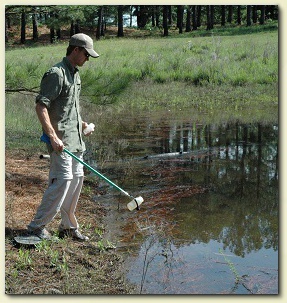
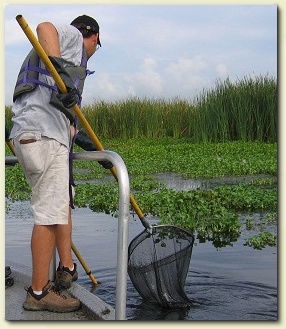




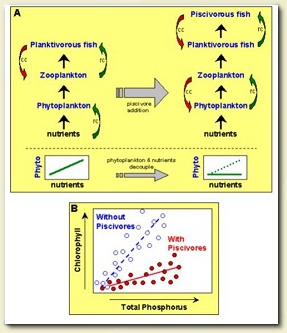
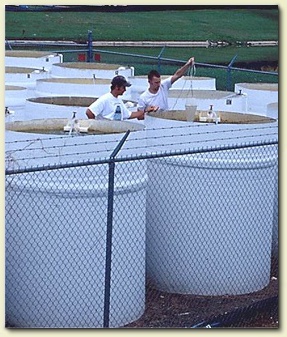
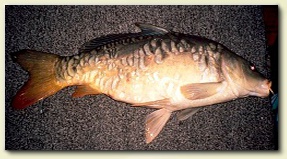
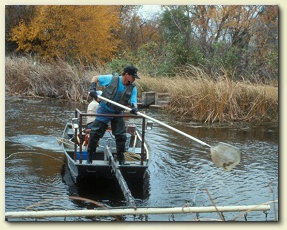

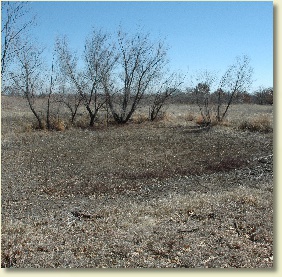
Ecological Research
Recent projects
Sulfur stable isotope indicators of residency in estuarine fish
Investigators: Brian Fry and Matthew M. Chumchal
Abstract: Estuarine fish may remain as residents in areas with favorable conditions for feeding and refuge, but become mobile and transient where conditions are less favorable. We developed a new approach involving sulfur stable isotope (d34S) distributions in fish muscle tissue to track residents and transients across estuarine salinity zones. Salinity tracking was based on d34S contrasts between freshwater and marine waters. This 5-yr study of two Louisiana estuaries showed that riverine and upper-estuarine fish consistently had low d34S values (25% to +5%) in contrast to fish from the lower, more marine portion of estuaries that had higher d34S values (11-17%). Residents were identified using tests of normality within community-level d34S distributions, and conceptually were considered animals permanently residing at the sampling station but also any animals present from nearby areas with similar salinities. Transients had d34S values atypical of both the location of capture and the local salinity regime. Results showed good resolution of fish movement at small 0.1-4-km scales for low-salinity (<2) upper-estuary stations, and good detection of long-range migrants from the upper estuary into the lower estuary at a coarser spatial scale of 10-30 km. On an average basis, 2/3 of the estuarine fish fauna was resident and 1/3 transient. Transients were a minority in most species but commonly included small as well as large fish. This novel d34S approach may be a general technique for evaluating fish residency and movement across salinity zones in estuaries.
Click here to download the article published in Limnology and Oceanography
Investigators: Brian Fry and Matthew M. Chumchal
Abstract: Estuarine fish may remain as residents in areas with favorable conditions for feeding and refuge, but become mobile and transient where conditions are less favorable. We developed a new approach involving sulfur stable isotope (d34S) distributions in fish muscle tissue to track residents and transients across estuarine salinity zones. Salinity tracking was based on d34S contrasts between freshwater and marine waters. This 5-yr study of two Louisiana estuaries showed that riverine and upper-estuarine fish consistently had low d34S values (25% to +5%) in contrast to fish from the lower, more marine portion of estuaries that had higher d34S values (11-17%). Residents were identified using tests of normality within community-level d34S distributions, and conceptually were considered animals permanently residing at the sampling station but also any animals present from nearby areas with similar salinities. Transients had d34S values atypical of both the location of capture and the local salinity regime. Results showed good resolution of fish movement at small 0.1-4-km scales for low-salinity (<2) upper-estuary stations, and good detection of long-range migrants from the upper estuary into the lower estuary at a coarser spatial scale of 10-30 km. On an average basis, 2/3 of the estuarine fish fauna was resident and 1/3 transient. Transients were a minority in most species but commonly included small as well as large fish. This novel d34S approach may be a general technique for evaluating fish residency and movement across salinity zones in estuaries.
Click here to download the article published in Limnology and Oceanography
Crustacean zooplankton community structure in temporary and permanent grassland
ponds
Investigators: S. Matthew Drenner, Stanley I. Dodson, Ray W. Drenner, John E. Pinder III
Abstract: Lentic community structure varies across a size gradient of ponds and lakes with physical factors, such as pond drying, and biotic factors, such as fish predation, determining the species assemblage. We studied the effects of pond drying and fish absence on crustacean zooplankton across a gradient of pond sizes in a Texas grassland. We determined the species compositions and size distributions of crustacean zooplankton in 20 temporary and 18 permanent ponds in April after March rains had refilled the ponds. The surface areas of temporary and permanent ponds ranged from <0.01 to 0.21 ha and 0.04 to 13.8 ha, respectively, and temporary ponds were significantly smaller, on average, than permanent ponds. Fish were absent from all temporary ponds and present in all permanent ponds. We detected a difference in the zooplankton species assemblages of the temporary and permanent ponds. Out of 14 total zooplankton taxa that occurred in eight or more ponds, seven taxa were significantly more prevalent in temporary ponds and four taxa were significantly more prevalent in permanent ponds. The sizes of zooplankton in the temporary fishless ponds were greater than those in the permanent ponds with fish present. We concluded that pond size mediated susceptibility to pond drying, and pond drying determined the presence and absence of fish and their secondary trophic-level effect on zooplankton community structure.
Click here to download the article published in Hydrobiologia
Investigators: S. Matthew Drenner, Stanley I. Dodson, Ray W. Drenner, John E. Pinder III
Abstract: Lentic community structure varies across a size gradient of ponds and lakes with physical factors, such as pond drying, and biotic factors, such as fish predation, determining the species assemblage. We studied the effects of pond drying and fish absence on crustacean zooplankton across a gradient of pond sizes in a Texas grassland. We determined the species compositions and size distributions of crustacean zooplankton in 20 temporary and 18 permanent ponds in April after March rains had refilled the ponds. The surface areas of temporary and permanent ponds ranged from <0.01 to 0.21 ha and 0.04 to 13.8 ha, respectively, and temporary ponds were significantly smaller, on average, than permanent ponds. Fish were absent from all temporary ponds and present in all permanent ponds. We detected a difference in the zooplankton species assemblages of the temporary and permanent ponds. Out of 14 total zooplankton taxa that occurred in eight or more ponds, seven taxa were significantly more prevalent in temporary ponds and four taxa were significantly more prevalent in permanent ponds. The sizes of zooplankton in the temporary fishless ponds were greater than those in the permanent ponds with fish present. We concluded that pond size mediated susceptibility to pond drying, and pond drying determined the presence and absence of fish and their secondary trophic-level effect on zooplankton community structure.
Click here to download the article published in Hydrobiologia
Copyright 2020 Matt Chumchal
Texas Christian University
2800 S. University Dr.
Fort Worth, Texas 76129
Texas Christian University
2800 S. University Dr.
Fort Worth, Texas 76129
Gape limitation, prey size refuges and the top-down impacts of piscivorous largemouth
bass in shallow pond ecosystems
Investigators: Weston H. Nowlin, Ray W. Drenner, Kirk R. Guckenberger, Mark A. Lauden, G. Todd Alonso1, Joseph E. Fennell & Judson L. Smith
Abstract: Top-down control of phytoplankton biomass through piscivorous fish manipulation has been explored in numerous ecological and biomanipulation experiments. Piscivores are gape-limited predators and it is hypothesized that the distribution of gape sizes relative to distribution of body depths of prey fish may restrict piscivore effects cascading to plankton. We examined the top-down effects of piscivorous largemouth bass on nutrients, turbidity, phytoplankton, zooplankton and fish in ponds containing fish assemblages with species representing a range of body sizes and feeding habits (western mosquitofish, bluegill, channel catfish, gizzard shad and common carp). The experimental design consisted of three replicated treatments: fishless ponds (NF), fish community without largemouth bass (FC), and fish community with largemouth bass (FCB). Turbidity, chlorophyll a, cyclopoid copepodid and copepod nauplii densities were significantly greater in FC and FCB ponds than in NF ponds. However, these response variables were not significantly different in FC and FCB ponds. The biomass and density of shallow-bodied western mosquitofish were reduced and bluegill body depths shifted toward larger size classes in the presence of largemouth bass, but the biomass and density of all other fish species and of the total fish community were unaffected by the presence of largemouth bass. Our results show that top-down impacts of largemouth bass in ecosystems containing small- and deep-bodied fish species may be most intense at the top of the food web and alter the size distribution and species composition of the fish community. However, these top-down effects may not cascade to the level of the plankton when large-bodied benthivorous fish species are abundant.
Click here to download the article published in Hydrobiologia
Investigators: Weston H. Nowlin, Ray W. Drenner, Kirk R. Guckenberger, Mark A. Lauden, G. Todd Alonso1, Joseph E. Fennell & Judson L. Smith
Abstract: Top-down control of phytoplankton biomass through piscivorous fish manipulation has been explored in numerous ecological and biomanipulation experiments. Piscivores are gape-limited predators and it is hypothesized that the distribution of gape sizes relative to distribution of body depths of prey fish may restrict piscivore effects cascading to plankton. We examined the top-down effects of piscivorous largemouth bass on nutrients, turbidity, phytoplankton, zooplankton and fish in ponds containing fish assemblages with species representing a range of body sizes and feeding habits (western mosquitofish, bluegill, channel catfish, gizzard shad and common carp). The experimental design consisted of three replicated treatments: fishless ponds (NF), fish community without largemouth bass (FC), and fish community with largemouth bass (FCB). Turbidity, chlorophyll a, cyclopoid copepodid and copepod nauplii densities were significantly greater in FC and FCB ponds than in NF ponds. However, these response variables were not significantly different in FC and FCB ponds. The biomass and density of shallow-bodied western mosquitofish were reduced and bluegill body depths shifted toward larger size classes in the presence of largemouth bass, but the biomass and density of all other fish species and of the total fish community were unaffected by the presence of largemouth bass. Our results show that top-down impacts of largemouth bass in ecosystems containing small- and deep-bodied fish species may be most intense at the top of the food web and alter the size distribution and species composition of the fish community. However, these top-down effects may not cascade to the level of the plankton when large-bodied benthivorous fish species are abundant.
Click here to download the article published in Hydrobiologia
Biomass-dependent effects of common carp on water quality in shallow ponds
Investigators: Matthew M. Chumchal, Weston H. Nowlin and Ray W. Drenner
Abstract: We examined the biomass-dependent effects of common carp (Cyprinus carpio) on water quality in 10 ponds at the EagleMountain Fish Hatchery, Fort Worth, Texas, USA. Ponds contained 0-465 kg ha) of common carp. We measured limnological variables at weekly intervals for four weeks in early summer, after which ponds were drained and the biomass of fish and macrophytes was determined. Common carp biomass was significantly positively correlated with chlorophyll a, total phosphorus, total nitrogen, and Keratella spp. density and negatively correlated to bushy pondweed (Najas guadalupensis) biomass. In addition, we combined our data with data from comparable studies to develop more robust regression models that predict the biomass-dependent effects of common carp on water quality variables across a wide range of systems.
Click here to download the article published in Hydrobiologia
Investigators: Matthew M. Chumchal, Weston H. Nowlin and Ray W. Drenner
Abstract: We examined the biomass-dependent effects of common carp (Cyprinus carpio) on water quality in 10 ponds at the EagleMountain Fish Hatchery, Fort Worth, Texas, USA. Ponds contained 0-465 kg ha) of common carp. We measured limnological variables at weekly intervals for four weeks in early summer, after which ponds were drained and the biomass of fish and macrophytes was determined. Common carp biomass was significantly positively correlated with chlorophyll a, total phosphorus, total nitrogen, and Keratella spp. density and negatively correlated to bushy pondweed (Najas guadalupensis) biomass. In addition, we combined our data with data from comparable studies to develop more robust regression models that predict the biomass-dependent effects of common carp on water quality variables across a wide range of systems.
Click here to download the article published in Hydrobiologia
Interrelationships between phosphorus loading and common carp in the regulation of
phytoplankton biomass
Investigators: Matthew M. Chumchal and Ray W. Drenner
Abstract: The interrelationship between phosphorus loading and common carp in the regulation of phytoplankton biomass was examined in a four-week summer mesocosm experiment. The factorial design consisted of two levels of phosphorus loading (with/ without) cross-classified with two levels of common carp (with/without). At the conclusion of the mesocosm experiment, common carp were removed from mesocosms and a nutrient excretion and defecation trial was performed. A significant interaction effect was detected between phosphorus loading and common carp for chlorophyll-a (a proxy for phytoplankton biomass), total nitrogen, and nitrogen : phosphorus. Common carp had modest effects on chlorophyll-a in mesocosms without phosphorus loading but relatively large enhancement effects on chlorophyll-a in mesocosms with phosphorus loading. Common carp increased total nitrogen in mesocosms with phosphorus loading but had no effect on total nitrogen in mesocosms without phosphorus loading. The synergistic effect of phosphorus loading and common carp on chlorophyll-a was due to nitrogen excretion and defecation by common carp and the subsequent enhancement of nitrogen in mesocosms with phosphorus loading.
Click here to download the article published in Fundamental and Applied Limnology (formerly Archiv Für Hydrobiologie)
Investigators: Matthew M. Chumchal and Ray W. Drenner
Abstract: The interrelationship between phosphorus loading and common carp in the regulation of phytoplankton biomass was examined in a four-week summer mesocosm experiment. The factorial design consisted of two levels of phosphorus loading (with/ without) cross-classified with two levels of common carp (with/without). At the conclusion of the mesocosm experiment, common carp were removed from mesocosms and a nutrient excretion and defecation trial was performed. A significant interaction effect was detected between phosphorus loading and common carp for chlorophyll-a (a proxy for phytoplankton biomass), total nitrogen, and nitrogen : phosphorus. Common carp had modest effects on chlorophyll-a in mesocosms without phosphorus loading but relatively large enhancement effects on chlorophyll-a in mesocosms with phosphorus loading. Common carp increased total nitrogen in mesocosms with phosphorus loading but had no effect on total nitrogen in mesocosms without phosphorus loading. The synergistic effect of phosphorus loading and common carp on chlorophyll-a was due to nitrogen excretion and defecation by common carp and the subsequent enhancement of nitrogen in mesocosms with phosphorus loading.
Click here to download the article published in Fundamental and Applied Limnology (formerly Archiv Für Hydrobiologie)
Piscivores, trophic cascades, and lake management
Investigators: Ray W. Drenner and K. David Hambright
Abstract: The concept of cascading trophic interactions predicts that an increase in piscivore biomass in lakes will result in decreased planktivorous fish biomass, increased herbivorous zooplankton biomass, and decreased phytoplankton biomass. Though often accepted as a paradigm in the ecological literature and adopted by lake managers as a basis for lake management strategies, the trophic cascading interactions hypothesis has not received the unequivocal support (in the form of rigorous experimental testing) that might be expected of a paradigm. Here we review field experiments and surveys, testing the hypothesis that effects of increasing piscivore biomass will cascade down through the food web yielding a decline in phytoplankton biomass. We found 39 studies in the scientific literature examining piscivore effects on phytoplankton biomass. Of the studies, 22 were confounded by supplemental manipulations (e.g., simultaneous reduction of nutrients or removal of planktivores) and could not be used to assess piscivore effects. Of the 17 nonconfounded studies, most did not find piscivore effects on phytoplankton biomass and therefore did not support the trophic cascading interactions hypothesis. However, the trophic cascading interactions hypothesis also predicts that lake systems containing piscivores will have lower phytoplankton biomass for any given phosphorus concentration. Based on regression analyses of chlorophyll-total phosphorus relationships in the 17 nonconfounded piscivore studies, this aspect of the trophic cascading interactions hypothesis was supported. The slope of the chlorophyll vs. total phosphorus regression was lower in lakes with planktivores and piscivores compared with lakes containing only planktivores but no piscivores. We hypothesize that this slope can be used as an indicator of "functional piscivory" and that communities with extremes of functional piscivory (zero and very high) represent classical 3- and 4-trophic level food webs.
Click here to download the article published in The Scientific World
Investigators: Ray W. Drenner and K. David Hambright
Abstract: The concept of cascading trophic interactions predicts that an increase in piscivore biomass in lakes will result in decreased planktivorous fish biomass, increased herbivorous zooplankton biomass, and decreased phytoplankton biomass. Though often accepted as a paradigm in the ecological literature and adopted by lake managers as a basis for lake management strategies, the trophic cascading interactions hypothesis has not received the unequivocal support (in the form of rigorous experimental testing) that might be expected of a paradigm. Here we review field experiments and surveys, testing the hypothesis that effects of increasing piscivore biomass will cascade down through the food web yielding a decline in phytoplankton biomass. We found 39 studies in the scientific literature examining piscivore effects on phytoplankton biomass. Of the studies, 22 were confounded by supplemental manipulations (e.g., simultaneous reduction of nutrients or removal of planktivores) and could not be used to assess piscivore effects. Of the 17 nonconfounded studies, most did not find piscivore effects on phytoplankton biomass and therefore did not support the trophic cascading interactions hypothesis. However, the trophic cascading interactions hypothesis also predicts that lake systems containing piscivores will have lower phytoplankton biomass for any given phosphorus concentration. Based on regression analyses of chlorophyll-total phosphorus relationships in the 17 nonconfounded piscivore studies, this aspect of the trophic cascading interactions hypothesis was supported. The slope of the chlorophyll vs. total phosphorus regression was lower in lakes with planktivores and piscivores compared with lakes containing only planktivores but no piscivores. We hypothesize that this slope can be used as an indicator of "functional piscivory" and that communities with extremes of functional piscivory (zero and very high) represent classical 3- and 4-trophic level food webs.
Click here to download the article published in The Scientific World
Abundance and size distributino of permanant and temporary fram ponds in the
southeastern Great Plains
Investigators: Matthew M. Chumchal, Ray W. Drenner and Kimberly J. Adams
Abstract: Using aerial images from the US Department of Agriculture National Agriculture Imagery Program and the US Geological Survey National Hydrology Dataset, we estimated 577 654 farm ponds with surface areas from 0.005 to 1 ha in a 229 489 km2 region of the southeastern Great Plains (2.52 ponds/km2). Ponds with surface areas from 0.005 to 0.1 ha were the numerically dominant size class in the study region. The distribution of farm pond sizes followed an inverse power law relationship. We estimated 376 209 permanent ponds and 201 445 temporary ponds were in our study area. The ratio of temporary to permanent ponds within a pond size class was inversely related to pond surface area; 47% of ponds with surface areas of 0.005–0.1 ha were temporary, whereas only 13% of ponds with surface areas of 0.91–1 ha were temporary. Because permanent and temporary farm ponds are abundant and have different physicochemical properties and ecological communities, assessments of regional biogeochemical processes and biodiversity in
the Great Plains must consider both types of ecosystems.
Click here to download the article published in Inland Waters
Investigators: Matthew M. Chumchal, Ray W. Drenner and Kimberly J. Adams
Abstract: Using aerial images from the US Department of Agriculture National Agriculture Imagery Program and the US Geological Survey National Hydrology Dataset, we estimated 577 654 farm ponds with surface areas from 0.005 to 1 ha in a 229 489 km2 region of the southeastern Great Plains (2.52 ponds/km2). Ponds with surface areas from 0.005 to 0.1 ha were the numerically dominant size class in the study region. The distribution of farm pond sizes followed an inverse power law relationship. We estimated 376 209 permanent ponds and 201 445 temporary ponds were in our study area. The ratio of temporary to permanent ponds within a pond size class was inversely related to pond surface area; 47% of ponds with surface areas of 0.005–0.1 ha were temporary, whereas only 13% of ponds with surface areas of 0.91–1 ha were temporary. Because permanent and temporary farm ponds are abundant and have different physicochemical properties and ecological communities, assessments of regional biogeochemical processes and biodiversity in
the Great Plains must consider both types of ecosystems.
Click here to download the article published in Inland Waters









